#community placemaking
Text
Principles and Practice of Community Placemaking
Placemaking creates places and focuses on transforming public places to strengthen the connections between the community and the places
0 notes
Text
The Power of Street Art: How Murals Can Transform Communities
In our visit with art forms around the world, this is #3 in the series. #1 was Mexican Folk Art, and #2 was Japanese Kintsugi.
Please feel free to revisit them or check them out if you missed them.
In cities around the world, blank walls and empty spaces are being transformed into vibrant works of art through street art and murals.
Far from being a nuisance, this public art form is having…
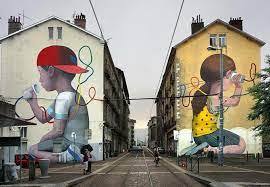
View On WordPress
#accessible art#art and community development#art for social impact#artistic empowerment#community engagement#community identity through art#community murals#creative placemaking#cultural expression#fostering creativity in urban spaces#graffiti and society#mural art#neighborhood beautification#public art benefits#public space transformation#social change through art#street art impact#urban aesthetics#urban revitalization#visual storytelling
2 notes
·
View notes
Text
Research findings: How are people creating a sense of togetherness online?
The everyday inventiveness of translocal relationship maintenance
I'm excited to share some early insights from our latest study. Some of you may remember it from when it was distributed: a survey about how people who sustain relationships online create a sense of being in the same place, even at a distance.
Even now, online platforms are marching towards a future of standardised, formless, and profoundly placeless design. But relationships need place (Tuan, 1979), and people will continue to fashion new tactics to address their everyday needs. So, how do people in translocal relationships play with/around these technological limitations? How do they foster shared places on platforms that aren't designed for it?
That's what our study sought to uncover, and here's what we found...
---
Our deepest thanks to all who participated in the survey! We had 44 respondents—almost twice as many as we were hoping for—and more importantly, we got a pretty broad slice of translocal connections across the world:
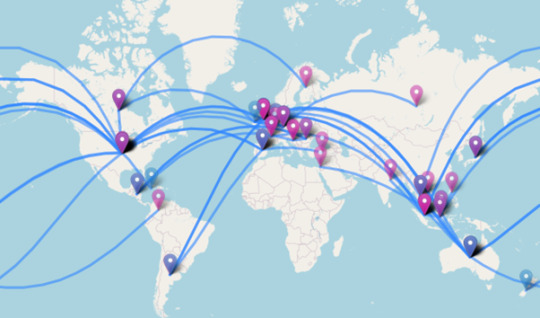
Our original focus was on long-distance families and romantic relationships, mainly because people conventionally assume physical closeness and cohabitation in those relationships. But in practice, the data we gathered contained accounts of all kinds of relationships, so we expect the findings to be relevant (in varying degrees) to many kinds of online connection as well.
Across the data, a few themes showed up repeatedly, and through an extensive process of coding and clustering, we've distilled it into five themes, or key drivers of practices in virtual placemaking:
1. Synchronicity ⌚
People seek to act in concert and in temporal proximity, to feel a sense of relatedness—be that by experiencing media together, collaborating on a project, or just feeling collocated via a background voice call. Voice calls often scaffolded these kinds of synchronous activities—sound is a great vector for conveying simultaneity/"at the same time."
2. Persistence 📌
We talked about synchronous interactions above. Asynchronous interactions, on the other hand, assert the "being in the same space." This requires virtual spaces to not simply disappear or refresh when the session is closed: you're able to leave artefacts for others to discover even when you're offline or "in the background," and they accumulate over time. That's a core trait of a real place (as discussed in past research).
3. Emotional connection/depth 🫂
We know from other research that long-distance couples favour text messaging. Verbal communication is paramount in relationship deepening because it supports precise expressions of care and affirmation. But it can be asserted by other expressions too, like offers of help, favours and gifts—implicitly or explicitly indicating that one has the other person in one's thoughts, as well as their interests, well-being, and goings-on.
4. Physical linkage 🔗
Despite the focus on virtual spaces, many respondents saw great importance in anchoring their bonds in physical space, and used technologies as windows, or bridges, linking those spaces together. Using video calls as "windows" to have meals together, virtual house tours where the smartphone acts as a surrogate for the person on the other end, buying the same game board and playing against each other by replicating each other's moves...our data was replete with creative ways of bridging physical divides.
5. Co-creation 🖼️📝
Collaborative narratives and creation uniquely allow for interactors to explore and cohabit a shared mental place, in which they have an equal stake and are emotionally engaged. It's a way of being psychically co-present through roleplay and active imagination. Our data was full of mentions of collaborative creative work and narratives, from Dungeons and Dragons to building worlds together to making art of imagined alternate realities.
---
Other neat insights:
Rather than ever being confined to a single platform, almost everyone inhabited and interwove practices across different platforms/media types, each with its own utility, affect, and meaning: this is what Madianou calls "polymedia life." Think playing games on a virtual board while discussing it in a text chat, watching a show together on a streaming website while discussing it in a call, playing Wordle independently and checking in with the group chat to see what others thought, etc. This was almost universal across the dataset!
There were a lot of unique practices described in the dataset (i.e. instances where one respondent was the only person in the dataset who did that thing) - and yet it was never described as a practice we deliberately designed to solve a problem. This everyday inventiveness among people in translocal/transnational relationships has become the core of our research interest.
Lots of intergenerational connection (parent/child, grandparent/grandchild, aunt/uncle/niece) was evidenced - and a strong skew towards text chat, video calls, and voice calls for these. Video games are far more common among romantic relationships.
---
That's all for this post—I'll be back soon (very soon) to talk about what comes next.
63 notes
·
View notes
Text
Regarding this post going around:

Recommend checking out an article by Kasey Keeler and Ryan Hellenbrand, published at Edge Effects in 2021, which, aside from addressing the Ojibwe story about the Nanabozho fighting against logging, also describes the origin of Paul Bunyan as an icon of clear-cutting timber industry and, later, as a symbol of the advent of the US federal government’s “German-style” forestry management.
Some quick tidbits from their article:
- References to Bunyan appear in local print media from the 1890s onward, but Bunyan became more widely known in 1916 after a scholarly publication about the folklore. In the same year, 1916, an important mass media pictorial representation was made in a promotional pamphlet by the marketing team of a major logging company as a move to give them a folksly and “local” charm as the corporation expanded from Minnesota to California.
- That same logging company had owned the land that would become both Paul Bunyan State Forest and Chippewa National Forest.
- The first national forest created by act of Congress rather than presidential proclamation was actually Chippewa National Forest, which has been described as “a laboratory” to solve “the Indian problem” and discipline/contain Ojibwe people.
- Paul Bunyan was a sort of icon of German folklore in the region. Ironically, even though Bunyan was originally associated with clear-cutting, it would in fact be "German-style” forestry policy that (in Minnesota and later across the US) replaced the original clear-cutting industrial extraction methods with a "modern" and "sustainable" management approach meant for "sustained yield" (which still just treats forests as a resource to be extracted for profit).
---
Anyway, some images, captions, and text from the article [all text below is excerpted from the article]:
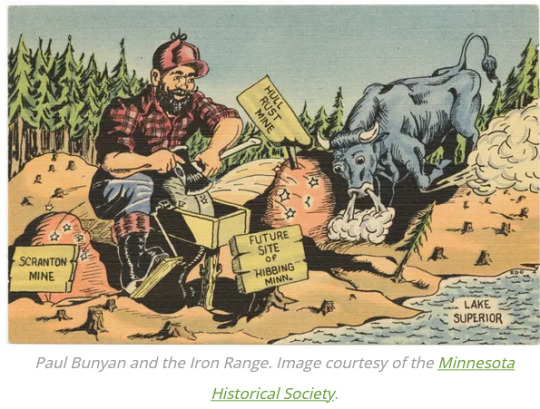
Across the Northwoods, a geography that spans the U.S.-Canada border, stories are used to make and claim space. [...] Throughout northern Minnesota, legends of Paul Bunyan, the fictional giant lumberjack, have been used to claim space. [...] Bunyan has been credited with creating Minnesota’s 10,000 lakes, the Mississippi River, and the Grand Canyon, while simultaneously logging millions of acres of forest. [...] Together, we juxtapose the history of two forests -- the Paul Bunyan State Forest and the Chippewa National Forest -- to reveal how German settlement, logging, and forestry have contributed to placemaking narratives, and how [...] nostalgia links past and present. Paul Bunyan’s literal and figurative imaginings advance American Indian erasure narratives, leading to the invisibility of these same communities today. [...] The Northwoods have been popularized and imagined as America’s version of northern Europe. [...] Across Minnesota, towns like New Ulm, New Munich, Heidelberg, and Luxemburg bear witness [...]. More recently, Native scholars Michael Dockry and Christopher Caldwell have examined [...] “the Menominee people’s profound sense of place and their intimate relationship with place.” [...]
---
Ojibwe dispossession, well underway by the late nineteenth century, is not told in any Paul Bunyan story. [...] The "heroic labor" of logging formed a significant portion of Great Lakes region economies [...] on the heels of, and entangled with, Ojibwe dispossession. [...] Formally established in 1908, the 1.6-million-acre Chippewa National Forest (CNF) lies nearly contiguous with the Leech Lake Reservation. [...] [T]he CNF was the first national forest created "for the benefit of [American] Indian people." [...] In 1902 came the Morris Act. Authored by [a] Duluth congressman [...], the act "created the first forest reserve established by congressional action rather than presidential proclamation." The act established the 225,000-acre Minnesota Forest Reserve as a “compromise,” a way to tackle the “Indian problem” while allowing for timber harvest. Here, Ojibwe homelands became “a laboratory for the first comprehensive forest management plans undertaken by a federal agency.” In 1928, the forest was renamed the Chippewa National Forest, as it remains today.
---
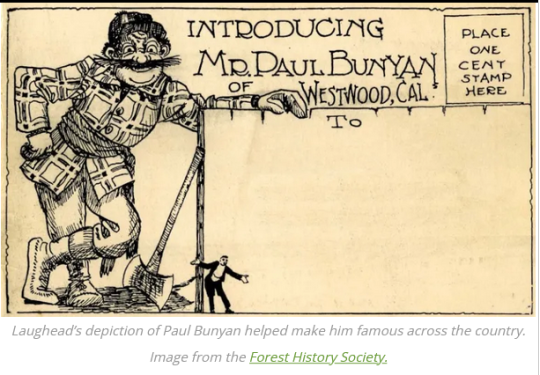
While the Chippewa National Forest forces us to consider the many ways logging and forestry has usurped American Indian peoples’ access to land, the nearby Paul Bunyan State Forest encapsulates the material legacy of symbolic myth. [...]
Officially recognized in 1935, the Paul Bunyan State Forest evolved from the site of the Red River Lumber Company sawmill. Founded in 1884, the Red River Lumber Company (RRLC) directly participated in and contributed to Ojibwe dispossession. By the end of the nineteenth century, he RRLC had purchased most of the land that comprises the present-day Pual Bunyan State Forest, milling millions of board feet of lumber at the company town of Akeley. [...]
The expansion of RRLC to California precipitated another key move: using Paul Bunyan in their marketing. William B. Laughead (pronounced Log-head), advertising manager in 1914 and a logger himself, spun another Paul Bunyan tale for the promotional booklet “Introducing Mr. Paul Bunyan of Westwood, Cal,” which included Bunyan’s first pictorial representation. This marketing campaign relied on the new and growing nostalgia for the grand logging days in the Great Lakes to keep the transcontinental corporation rooted in place.

With logging long established throughout the Great Lakes region, the ecological damage was clear. To remedy this, in the mid-1930s (German) forestry was introduced to manage timber on a sustained yield base. This, then, is the irony of the Paul Bunyan State Forest: named for an American legends who is said to have literally cleared the path for settlement, forest management now proposes to maintain the integrity of the forest. [...]
Though Paul Bunyan narratives dominate the landscape of the Northwoods, if we look closely we can see the ways Native people resist the legendary exploits. Indeed, a lesser-known Ojibwe oral story reminds us that the Anishinaabe people, their culture, and their histories will always prevail over dispossession and logging. In the story, Nanabozho, an Ojibwe trickster or cultural figure, confronts Paul Bunyan, who had already logged off most of the northeastern states before making his way to Minnesota. Nanabozho tells Paul to leave, to not log any more timber. A fight ensues, and [...] Nanabozho swings a Red Lake walleye at Paul, knocking him off his feet. As Paul stumbles, Nanabozho pulls at Paul’s whiskers, making him promise to leave the area. This is why, today, Paul Bunyan does not have a beard and why he is facing west at the statue on Lake Bemidji, as he prepares to leave the region.
This is also why we have the Chippewa National Forest, because Nanabozho and his Ojibwe kinsmen saved it from being logged. It is this contemporary narrative that highlights the complexity of Ojibwe storytelling [...].
---
Images, captions, and text as published by: Kasey Keeler and Ryan Hellenbrand. “Paul Bunyan and Settler Nostalgia in the Northwoods.” Edge Effects. 2 December 2021. [Bold emphasis and some paragraph breaks added by me.]
#abolition#ecology#indigenous#great lakes#imperial#colonial#ojibwe#victorian and edwardian popular culture#tidalectics#imperial forestry#multispecies#interspecies#geographic imaginaries
383 notes
·
View notes
Text
The Jewish Community of the Virginia Peninsula is shocked and alarmed at LoveLight Placemaking’s decision to cancel a menorah lighting scheduled for the Second Sundays Art and Music Festival on Dec 10 in Williamsburg – claiming it did not want to appear to choose sides in the Israel-Hamas conflict. To be clear, the menorah lighting, which was to be led by a local community rabbi, had nothing to do with Israel or the conflict.
Yet, appallingly, the event organizer claimed that a Chanukah celebration would send a message that the festival was "supporting the killing/bombing of thousands of men, women, and children," -- and even went a step further, by offering to reinstate the event if it was done under a banner calling for a ceasefire.
We should be very clear: it is antisemitic to hold Jews collectively responsible for Israel’s policies and actions, and to require a political litmus test for Jews’ participation in community events that have nothing to do with Israel. Those standards would never be applied to another community.
Since October 7th, we have repeatedly seen cases of Jewish people and institutions – including synagogues, Jewish homes and businesses – being targeted, sometimes violently, by those opposed to Israel or its actions. At a time of well-documented, rising antisemitism, the singling out and targeting of Jews is dangerous and harmful, serving to further exclude and alienate our community.
The Second Sundays Art & Music Festival has been a meaningful and important community event that brings people together under a powerful message of unity, love and light. Excluding Jewish participation from a festival that should welcome everyone undermines its very message. We call on LoveLight Placemaking to reconsider our request to engage in dialogue, educate themselves on the harmfulness of their decision, and reinstate the apolitical Menorah ceremony at the event.
#jewish community of the virginia peninsula#chanukah#collective responsibility#second sundays art & music festival
27 notes
·
View notes
Text
If you believe that celebrating a Jewish holiday in the United States is interpreted as either endorsement or condemnation of anything done by the State of Israel, then you are the reason the IHRA working definition of antisemitism exists. How is this a bigotry any different than declining to acknowledge Eid al-Fitr by association with Daesh, or Nowruz because of the Islamic Republic's brutality toward women? Except this is worse, because Israel didn't even start this war, which was precipitated by a savage attack that was the single deadliest day for Jews since the Holocaust.
If Williamsburg is going to cancel any holiday celebrations, cancel Christmas in honor of all the victims of Christendom. Don't demand that Jews agitate for the survival of a terrorist organization that openly calls for our genocide. Shame on LoveLight for this.
10 notes
·
View notes
Text
Reimagining the Renaissance Center
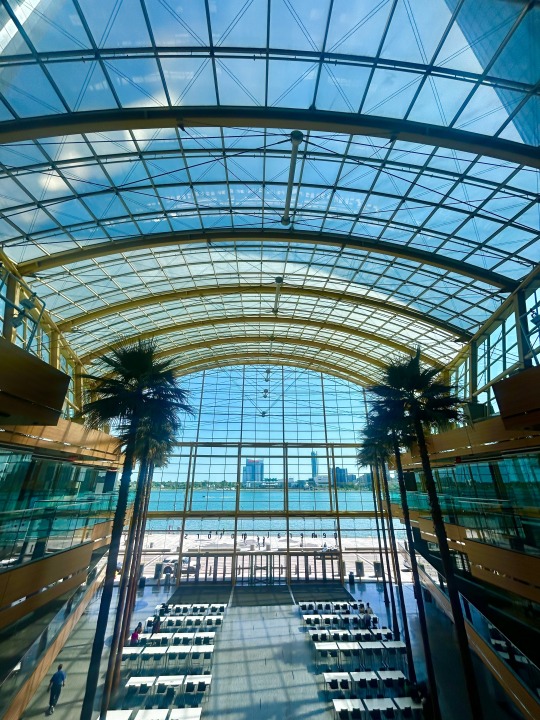
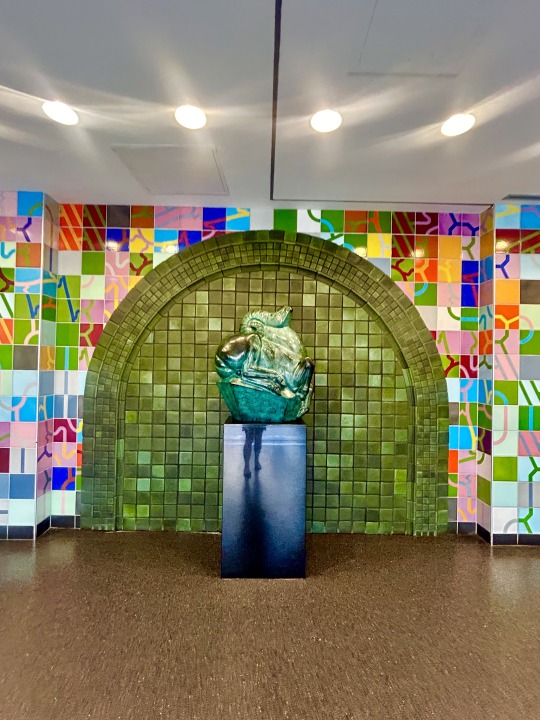
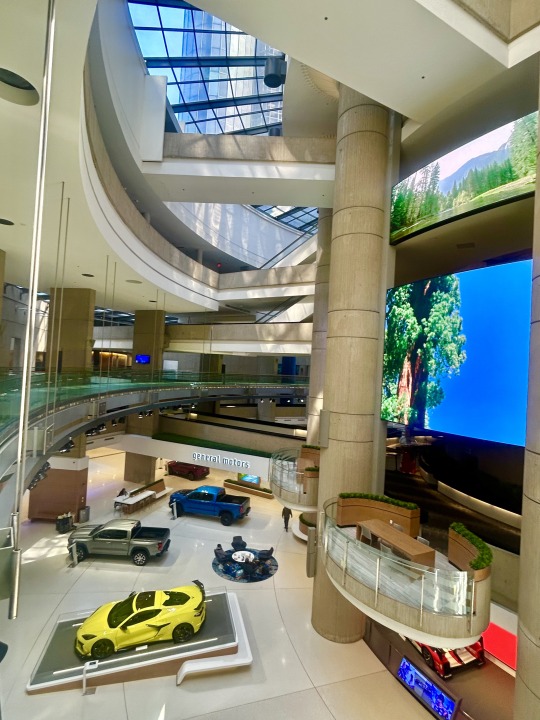
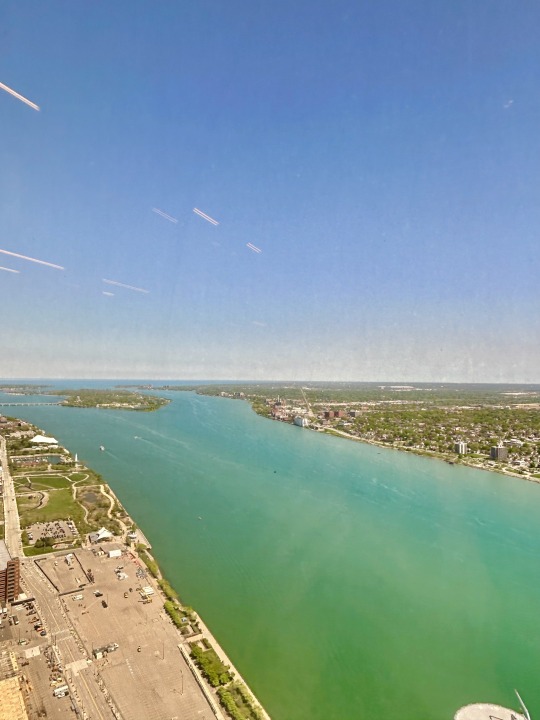
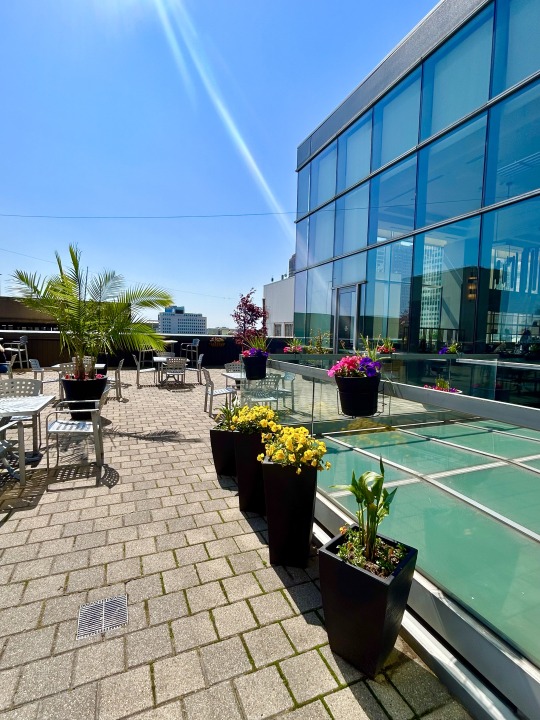

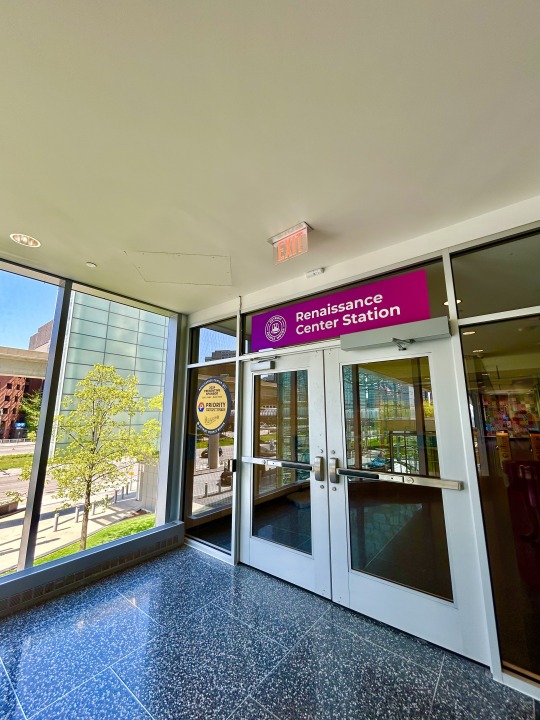
While working on my "Art in the Stations" blog series earlier this year, I began familiarizing myself with the Renaissance Center, home to General Motors.
I never had a reason to walk inside before, so after researching the art in the People Mover Station, I decided to start roaming around the towers- and discovered how empty they were.
I envisioned apartments, shops, cafes, and new restaurants occupying all the empty space. The location is perfect for a walkable neighborhood, yet the area seems to shut down after 5PM. The Riverwalk is one of Detroit's true gems, and I can't think of a better place for a new community in our beautiful city.
I've chatted with others about this over the past few months and was met with resistance. "GM would never let that happen," they would say.


I've also biked through blocks of cement and nearby empty parking lots, also owned by General Motors (and home to the Grand Prix), imagining parks, trees, and bike paths along the Detroit Riverwalk. As I look at all the unused space, dreams of placemaking and streets for people filled my mind.
The RenCen has been the headquarters of GM since they purchased the towers in May of 1996, but it was recently announced that they will be moving into the Hudson's building in 2025.
So, what is next for the Renaissance Center? I chatted with Radio Free Urbanism about this on their recent podcast, and it was interesting to hear their perspective about these iconic John Portman structures.
youtube
Who will purchase the towers? How will they occupy the space? The future is unclear, but there's amazing potential to create a beautiful neighborhood for the city to enjoy.
Let me know what you think!

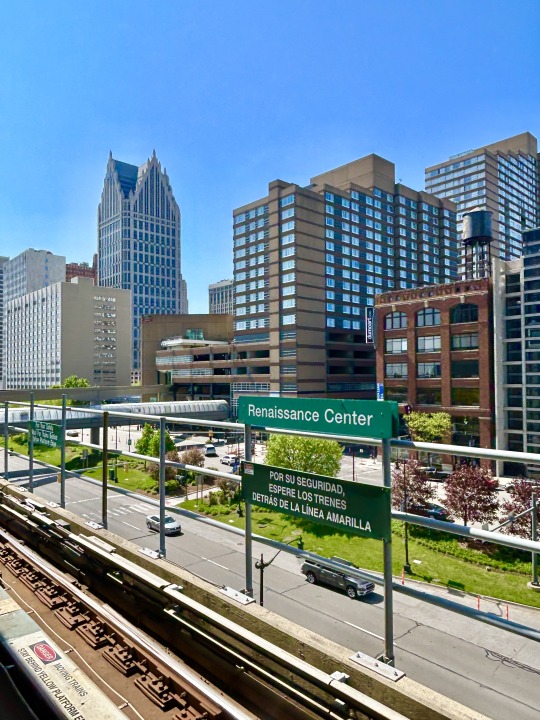
#generalmotors#downtowndetroit#mixedusedevelopment#mixedusebuilding#detroitpeoplemover#publictransit#detroit#carfree#walkingdetroit#placemaking#citiesforpeople#detroitparks#detroitriverwalk#riverwalk#Youtube#renaissancecenter
4 notes
·
View notes
Text
June 2024 News: Arts & Ideas Bike Rides; Events at the Learning Corridor; "Ride the State" June 22; Shoreline Greenway Trail Walk Part II

Dear Friend of the Farmington Canal Greenway,
We wanted to wish you a happy summertime and provide you with a few important updates:
* Arts & Ideas Festival Farmington Canal Bike Ride, Saturday, June 15, 9am-12pm

Join Elm City Cycling and the International Festival of Arts & Ideas for a bike ride on the Farmington Canal. The ride will be approximately 3 hours and will leave from the New Haven Green at 9am. Helmets and registration are required. Register here.
As part of Arts & Ideas, there will also be a Shoreline Greenway Trail bike ride on June 22 that may be of interest.
* "All Things Pollinators" Event at the Learning Corridor, Saturday, June 15, 10am - 1pm

Join our partner organization Community Placemaking & Engagement Network (CPEN) for a special "All Things Pollinators" celebration at the Urbanscapes Native Plant Nursery, located next to the Trail at the Newhallville Learning Corridor. In addition to the plant sale, there will be numerous exhibitors and workshops and lots of family-friendly activities at the nursery. Rain date is June 16.
* "Ride The State," Saturday, June 22, 2024 -- Only a Few Spaces Left!

This is a great opportunity to ride the Farmington Canal Heritage Trail all the way from New Haven to Massachusetts in a supported group ride setting. It is an amazing way to see the many sides of Connecticut including both historic cities and rural scenery. There will be a shuttle returning riders from Massachusetts to New Haven after the ride is complete. “Ride The State” is always a great experience and a unique way of seeing Connecticut! Register here. (We have some scholarships available for low-income riders -- please contact us if interested in this opportunity.)
* SAVE THE DATE: Preview the Shoreline Greenway Trail Extension into New Haven, Part II of II -- Sunday, August 18, 9:30am-12:30pm

On April 20 we completed Part 1 of our walking preview of the Shoreline Greenway Trail extension in New Haven, following up on the City of New Haven's release of new plans for the trail back in March. Read more about the walk in the New Haven Independent. Part I covered the area between Lighthouse Point and Fort Hale Park, and Part II will cover the section between Fort Hale and Long Wharf. Stay tuned for details on Part II in our next newsletter!
* CT Trail Census - Get Involved with this Awesome Data Project!
We are really glad to be participating in the CT Trail Census again this year, as we have since 2017. Participating in this research project provides us really valuable data about trail usage in New Haven and across the state.

Last year our infrared counters showed that there were over 150,000 trips taken on the trail in New Haven, and the trendline continues to go up, up, up! We need help this year with collecting manual count forms that enable us to calibrate our infrared sensors. Please contact us if you are interested in helping out with this fascinating and useful project – we really need help completing some manual counts to make sure our infrared counter is calibrated correctly!
_________________________________________
As always, thank you for your ongoing support.
New Haven Friends of the Farmington Canal Greenway
www.newhavencanalfriends.org
facebook.com/NewHavenCanalFriends
2 notes
·
View notes
Text
Movie Analysis: Goncharov and the 15-Minute City
The resurgence of Goncharov (1973) is an opportunity to explore European urbanism in the context of the film and the power of human-scale places.
Naples is often described as a gritty, chaotic and rough city that may feel unwelcoming to visitors. However, the saying “Rome is the heart of Italy, but Naples is its soul” is much more accurate. The city's grittiness lends itself well to the pulse-pounding action sequences in the film but the human-scale of the city also drives home the intimacy of the film's more tender moments.
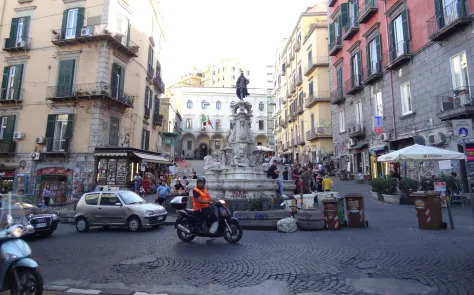
The pictured piazza is part of one of the film's pivotal moments. How would this scene have been different when things aren't at human-scale?
The city may not be shiny and neat, but it is an ideal version of the type of 15-minute city many New Urbanists are trying to create in North America today. It obtains traces of qualities often sought in today’s development strategies: communality, social inclusion, a wealth of creative activity and a locally rooted economy.
The streets in Naples are lined with local services. There’s a mix of everything old and new: bars, Michelin-praised pizzerias, car repair shops, meat shops, designer shops, and whatnot. Many of these places feature prominently in the film. Can you imagine how some of these scenes would have been impacted if Goncharov and Andrey had to get in a car and find parking as they traverse the city?
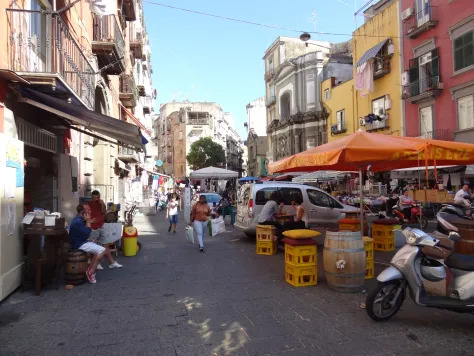
The “15-minute city” may be defined as an ideal geography where most human needs and many desires are located within a travel distance of 15 minutes.
Indeed, with all its “messiness”, Naples has managed to maintain many aspects of the self-organized, organic, urbanism that we’ve so often lost. The city is like a giant placemaking effort: incrementally built, maintained and continuously re-envisioned from the bottom up through the transactions and activities of a variety of local actors.
While not the focus of the film, the city of Naples is a great example of what the 15-minute city should and could be. By paying attention to the human-scale of the city, you can see how the design of cities shapes our daily lives.
Language and images sourced from: https://urbanfinland.com/2017/08/24/urban-lessons-from-naples-potenza-and-matera/
Learn more about the 15-minute city at: https://www.cnu.org/publicsquare/2021/02/08/defining-15-minute-city
23 notes
·
View notes
Photo

For the 10th Anniversary of the @designmuseumchi we are reflecting on where design has been and where it can go in the future. The museum is hosting a series exploring ten areas where design has the potential or the responsibility to make a future impact. Join us on Monday, March 20th at 6:00pm for “With Love, Southside,” a conversation with Rob McKay (@themrmckay), Eric Williams (@i_know_eric), and Chef Gabrielle (@chef.gabrielle) at Bronzeville Winery. [Link In Bio To Register] Bronzeville Winery (@bronzevillewinery) is one of Chicago’s newest culinary destinations. Situated on the Southside, Bronzeville Winery is a statement to the cultural prowess of a part of the city that has long been overlooked. “With Love, Southside” is a conversation about community-driven impact, design with care, hospitality, and placemaking on the Southside of Chicago. This series is dedicated to the incomparable Jon Veal, a founding member of DMoC’s Auxiliary Board, who transformed Chicago through his passion for people and life. Specials thanks to our series sponsors @UJAMAAConstruction. #chicago #design #designmuseumofchicago #art #southside #hospitality #communityimpact #placemaking #architecture (at Bronzeville Winery) https://www.instagram.com/p/Cp8Ge6Uu4eL/?igshid=NGJjMDIxMWI=
#chicago#design#designmuseumofchicago#art#southside#hospitality#communityimpact#placemaking#architecture
7 notes
·
View notes
Text
Bronzeville Legends Mural Initiative Wins 2023 Landmarks Illinois Richard H. Driehaus Foundation Preservation Award

The Richard H. Driehaus Preservation Awards honors individuals, organizations, and programs demonstrating a commitment to historic preservation.
I am pleased to announce that our public art initiative, Bronzeville Legends, has won the 2023 Landmarks Illinois Richard H. Driehaus Foundation Preservation Award for Cultural Heritage Preservation.
Bronzeville Legends, launched in 2014, is a curated multi-site placemaking campaign that uses large murals of the South Side community’s past residents to celebrate Bronzeville’s rich heritage.
Other award winners this year include the Old Post Office Chicago Adaptive Reuse Project, the Tribune Tower Renovation and more.
Learn more about ours and our fellow award-winning preservation efforts at Landmarks Illinois’ website. And, help us celebrate at the 2023 awards ceremony in Chicago on October 27!
More information can be found at the link below.
#chris devins#streetart#graffiti#chicago#bronzeville#photooftheday#landmarksillinois#chicagomurals#chicagostreetart
2 notes
·
View notes
Text
"‘Informal placemaking’ refers to the fact that the ‘slum’ has actually been made as a valued place against great odds over many decades through inspiring processes of community building and leadership. The severance of this informal place — cut in two by the fast road — cannot be seen as the isolated effect of a single road. Rather, it is the city's road network as a whole which JVLR [the aforementioned road] strengthened and which privileges elite lives and economies that must be seen to have maimed place. Of course, as elsewhere, the community vigorously protested this maiming, asserting a right to place with some success, but also faced new burdens. JVLR thus urges us to rethink the social cost of aspirational infrastructure."



5 notes
·
View notes
Text
09/22/2023
Week Two:
As I leave University City and venture into North West Philadelphia, I begin to notice how neighborhoods in the city have distinct identities and cultures. This diversity reflects Jane Jacobs' emphasis on the importance of neighborhood character. University City, with its blend of academic institutions, residential areas, and commercial zones, showcases the dynamic interplay of urban life. It's a place where students, professors, residents, and entrepreneurs coexist, contributing to a rich tapestry of diversity. Something that has continuously been echoed by Professor Gershberg during lectures, cities continue to be a space in which people from diverse backgrounds intermix, and considering just how many universities are located in close proximity, it almost feels like a unique geographic bubble.
Driving through University City and into Powelton Village, I witnessed mixed land use in action. Jacobs advocated for a mix of residential, commercial, and recreational spaces within neighborhoods, creating vibrant streetscapes. The locally-owned cafes, shops, and community centers that line Lancaster Avenue embody this principle. These small businesses not only add to community life but also enhance the walkability and social vitality of the area. This allows many of the residents which tend to be students the flexibility to participate in a variety of activities. This range allows for anyone to be walking distance from a locally owned barber shop or the farmers market, which highlights the importance of public spaces and placemaking. As I arrived at the Philadelphia School for the Deaf, the campus's green spaces and inviting architecture provide an environment where students, faculty, and visitors can gather, connect, and learn. This not only highlights parts of Jacobs’ themes, but takes into consideration Deaf Space and Deaf architecture.
1 note
·
View note
Text
Edmonton Arts Council celebrates the achievements of 20 local professional artists
The Edmonton Arts Council, City of Edmonton, and Edmonton Community Foundation are pleased to announce the 2022 recipients of the Edmonton Artists’ Trust Fund awards.
Twenty (20) artists have been awarded a 2022 Edmonton Artists’ Trust Fund award. Each award is $15,000, for a total of $300,000.
"We are so pleased to support and celebrate these 20 inspiring artists,” said Sanjay Shahani, Executive Director of the Edmonton Arts Council. “Our diverse arts community is one of the forces that brings our city together and makes the Edmonton region a vibrant and exciting place to live. The 2022 recipients demonstrate commitment and excellence in their respective disciplines, helping to foster an exciting ecology of creation and expression in Edmonton."
“Congratulations to this year’s recipients of the EATF,” said Tina Thomas, CEO of Edmonton Community Foundation. “We are thankful for the creative contributions this cohort of recipients have made to our city, and we look forward to the new works that they will produce with support from this important initiative."
The Edmonton Artists' Trust Fund (EATF) recognizes an artist’s work and contribution to the community. The $15,000 awards provide financial stability for artists to renew, develop, create or experiment. These awards are supported by the proceeds from the Edmonton Artists’ Trust Fund, held by the Edmonton Community Foundation.
Recipients of the 2022 Edmonton Artists’ Trust Fund:

Clockwise from top left: AJA Louden, photo by Leah Louden; Ann Vriend, photo by Johwanna Alleyne; Connor Yuzwenko-Martin, photo by Alexa Hickox; Dylan Toymaker, photo supplied by the artist.
Adrian (AJA) Louden (he/him) is a Jamaican-Canadian artist committed to challenging the negative perceptions of street-based art and making art accessible and relatable. His Aerosol Academy series uses the lens of graffiti and street art to get youth excited about art making and art history, and he is an active mentor working to remove barriers and support emerging artists.
Ann Vriend (she/her) is a two-time Maple Blues Award songwriting recipient, a Maple Blues Keyboardist of the Year nominee, an Edmonton Music Award and Alberta Centennial Award recipient, and has sold nearly 30,000 albums off-the-stage in her under-the-radar yet critically acclaimed international career. She is a passionate advocate for empowerment and respect for the members of her inner-city neighborhood of McCauley, Edmonton.
Connor Yuzwenko-Martin (he/him) is a Deaf creator, public relations specialist, actor, producer, and playwright. He is currently writing and producing his first original script, After Faust, in partnership with RISER Edmonton. He is also launching The Invisible Practice, a hybrid Deaf arts collective and public relations agency.
Dylan Toymaker (he/him) is a light design and installation artist. His focus is on creative placemaking through the sculpture of light and shadow. As a designer, creator and curator, his practice involves environmental and architectural public art events. Dylan has created and curated art for the Flying Canoe Volant festival and many other Alberta festivals.

Clockwise from top left: Gail Sidonie Šobat, photo by Geoff McMaster; Katrina Beatty, photo by Ian Jackson; Kevin Cardinal, photo provided by the artist; Lianna Makuch, photo by LV Imagery.
Gail Sidonie Šobat (she/her) is an author, creator-director of YouthWrite®, SpokenWord Youth/Adult Choirs, and is an instructor in MacEwan’s Communications program. Her work has won a number of awards, is published in academic and literary journals, anthologies, broadcast on radio, and performed on stage.
Katrina Beatty (she/her) is a filmmaker whose work includes short and feature films, web series, music videos and multi-media projections. She was awarded “Outstanding Music Video” at FAVA Fest in 2018 for her concept and direction of Juno Award winning band Whitehorse’s video “Pink Kimono”. More recently, Katrina produced the Telefilm funded feature film Before I Change My Mind, which premiered at the Locarno Film Festival in August 2022.
Kevin Cardinal (he/him) is a Cree acrylic painter/muralist who uses art to represent teachings, principles, knowledge, and understandings gained from attending ceremonies throughout the years. Kevin’s work reflects his search for inner peace, healing, and balance. His painting style is inspired by the bold black lines, and vibrant colors of the woodland style of art.
Lianna Makuch (she/her) is a Ukrainian Canadian playwright, performer, director, and co-Artistic Producer of Pyretic Productions. Her work has garnered awards and recognition nationally and in Ukraine, including the Shevchenko Foundation’s 2020 REACH Award. By exploring themes connected to her Ukrainian identity, she endeavours to create empathetic performance experiences with universal impact.
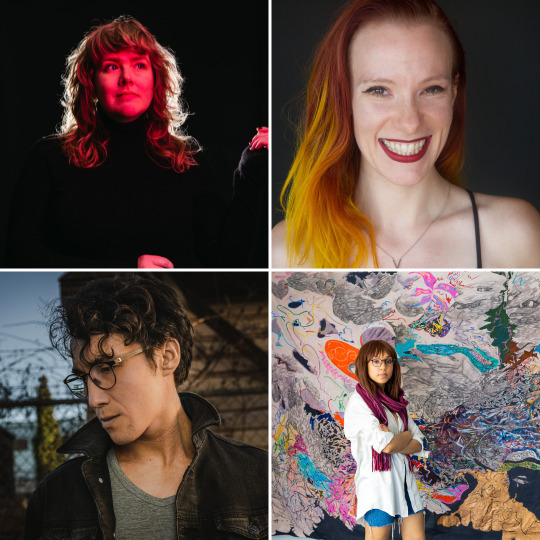
Clockwise from top left: Lindsey Walker, photo by Briane Jang; Louise Casemore, photo by Jody Christopherson; Madeline LeBlanc, photo provided by the artist; Mat Cardinal, photo provided by the artist.
Lindsey Walker (she/her) is an award-winning singer-songwriter, multi-instrumentalist, composer, and theatre performer. Lindsey wrote the score and lyrics for ren & the wake, an original semi-immersive musical created with Catch the Keys Productions. She also composed the score for the podcast “Natural Life” and composed the sound design for the theatre productions Re:Construct (Donkey Dog Theatre) and Shock Me Electra (Theatre Network Young Company).
Louise Casemore (she/her) is an advocate, performer, and two-time Sterling Award winning playwright. Original works include OCD, GEMINI, and Undressed, which recently premiered with Alberta Theatre Projects. She remains active in the national community by way of dramaturgy, research, and as an Artist Consultant focused on HR mechanisms for arts organizations.
Madeline LeBlanc (she/her) is a visual artist who strives to create inclusive spaces for audience participation, highlighting issues of accessibility in the industry. Her artwork may appear lighthearted and fun, but beneath the surface lies important commentary on the dynamics of classism in the art world and the pressure put on artists and markets by art collectors.
Mat Cardinal (he/him) is from Wabasca, Alberta and a proud member of the Bigstone Cree Nation. Mat is the lead singer of The Prairie States, a nine-time Country Music Alberta Award recipient and nominee for Songwriters of the Year 2022 at the Canadian Country Music Awards. Mat takes his role as a mentor for Indigenous youth seriously as his hard work/passion for performing/songwriting make waves in the music industry.
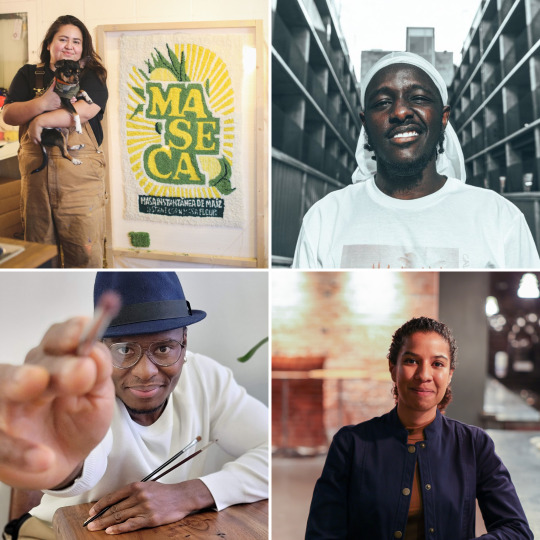
Clockwise from top left: Michelle Campos Castillo, photo by Fern Facette; Mouraine, photo provided by the artist; Nauzanin Knight, photo by Motif Photography; Reckie Lloyd, photo provided by the artist.
Michelle Campos Castillo (she/her) is a graphic designer and artist born in El Salvador. She has received several public art commissions from the City of Edmonton, including Platanos at the Belvedere Transit Centre, and is finalizing artwork for the Valley Line West LRT. She is currently working on a graphic memoir titled Colonia, based on her life in El Salvador during the country’s civil war.
Mouraine (he/him), who immigrated from Sudan at an early age, makes soulful hip-hop with a reverence for place and community, and a strong political sensibility. His debut EP Bigger Dreams was released in 2021.
Nauzanin Knight (she/her) is the CEO/Director of 1844 Studios. She got her start as a published writer, going on to write, direct and produce numerous films. Nauzanin is an alumnus of Women in the Director’s Chair, Sundance Collab (2020), BANFF Spark (2020) and ReelWorld (2021). An ardent contributor to her community, Nauzanin has led projects including, “Building Inclusive Networks in the Film & Television Industry” (Telefilm, CMF, 2021).
Reckie Lloyd (he/him) is a visual artist and the founder of Sangea Academy, a West African drumming and dance entity that shares the power of percussion with Canadians. During the Covid 19 Pandemic, Reckie found himself rediscovering his love for fine arts, refining his painting techniques and creating from a mature perspective.

Clockwise from top left: Robbie Townsend, photo provided by the artist; Tai Amy Grauman, photo by Emilie Igiotti; Vikki Wiercinski, photo by Cooper O'Hara; Tia Ashley Kushniruk, photo by Kendra Epik.
Robbie Townsend (AKA Father Bobby) (he/him) is a Juno nominated music producer, songwriter and multi-instrumentalist. He has built a reputation as an artist-focused producer, placing value on the song above all else, with the goal to create a specific colour palette for each project he takes on, helping artists discover, shape and redefine their sounds.
Tai Amy Grauman (she/her) is an actor, playwright, director and producer of Métis, Cree and Haudenosaunee heritage. She is currently defending her thesis for her MFA in theatre practice at the U of A with a focus on her artistic research of 'Metis women's love stories' and is adapting 'Romeo and Juliet: A Metis love story' as well as adapting her play 'You used to call me Marie...' into a limited film series.
Tia Ashley Kushniruk (亚 女弟) (she/her), a queer woman of Chinese-Ukrainian settler heritage, has been affiliated with the Cirque Du Soleil since 2013 and is a frequent collaborator of Jake W. Hastey (Toy Guns Dance Theatre). Tia is the inaugural recipient of the CONFLUENCE Fellowship from Catalyst Theatre and is a current company member of Shay Kuebler/RSA. In addition to theatre and dance, Tia is also an illustrator and animator.
Vikki Wiercinski (she/her) is an artist, ceramicist and designer focused on weaving together ceramic sculpture and drawing. She also works as the lead organizer of the Royal Bison Art and Craft Fair and creates textile and surface designs for her Mezzaluna Studio project.
5 notes
·
View notes
Text
Magazine on Book on Affordable Housing
My Liveable City is a global knowledge platform, established in 2014 with the objective of highlighting issues that make cities across the globe inequitable from the perspective of - affordable housing, inclusivity, environmental sustainability, etc,
All direct outcomes of staggeringly rapid speed and need of urbanisation that we're witnessing around us.

Over the years a network of global experts from the fields of Urban Design / City Planning / Landscape Architecture, Environmental Planning / Technologists, who in their role as practitioners, academicians, policy makers, as part of organisations that work at the ground level, have used My Liveable City’s platform to deliberate these challenges and have shared their views on feasible solutions, shared case studies of successfully implemented projects.
Over the last decade, we have successfully expanded our capabilities of presenting our knowledge in different formats, such as - Print magazine, Online content, Books, Conferences, Expert Programs, Customised workshops, Campus activation, Knowledge Tour, etc.
My Liveable City’s book on affordable housing titled “Affordable Housing, Inclusive Cities”, explores the interface of social justice and city making through comparative discussions from Asia, Africa, Australia and Europe, as well as North, Central and South America. Pressing issues of housing affordability are deliberated, innovative solutions and insightful analysis to address the global housing crisis are offered in the book. From illustrating creative financial models to community land trusts, from modular construction to regulatory reforms, our book on affordable housing highlights diverse strategies for making housing more accessible and affordable for all.
The thirty six essays within “Affordable Housing, Inclusive Cities” book include conversations with influential administrators and civic leaders such as Somsook Boonyabancha, secretary-general of the Asian Coalition for Housing Rights, and Jaime Lerner, architect and mayor of Curitiba, who transformed Curitiba into a ‘global laboratory’ for transit planning, placemaking, and housing. Commentaries on transformative initiatives such as ‘Child Friendly Cities’, and ‘Women for the World’. And case studies of exemplary housing projects by globally known architects and planners such as Alejandro Aravena and MVRDV, (some additional expanding their housing projects). Whether you're a policymaker, urban planner, developer, or concerned citizen, “Affordable Housing, Inclusive Cities”, will offer comprehensive resource to equip you with the knowledge and inspiration needed to foster equitable and inclusive housing solutions in your community.
To read a free chapter from our book on affordable housing or for purchasing this book click the link below https://www.myliveablecity.com/book/detail/affordable-housing-inclusive-cities
Subscribe to Knowledge !!!
0 notes
Text
The Importance of Art and Culture in Community Development

Art and culture play a vital role in shaping the identity, cohesion, and vibrancy of communities worldwide. Beyond their aesthetic value, artistic and cultural activities contribute to social, economic, and environmental development in various ways. Here, we delve into the significance of art and culture in fostering community development.
1. Cultural Heritage Preservation
Art and culture serve as repositories of a community’s history, traditions, and values, fostering a sense of continuity and belonging across generations. Preserving cultural heritage through art forms such as music, dance, storytelling, and visual arts not only honors the past but also strengthens social cohesion and identity within communities. Cultural heritage preservation also attracts tourists, generates economic opportunities, and sustains local economies, particularly in heritage-rich areas.
2. Social Cohesion and Inclusion
Art and culture have the power to bridge divides, foster understanding, and promote social cohesion among diverse communities. Cultural events, festivals, and exhibitions provide opportunities for people from different backgrounds to come together, celebrate shared traditions, and appreciate cultural diversity. Through collaborative art projects and cultural exchanges, communities can overcome barriers, challenge stereotypes, and build relationships based on mutual respect and empathy, fostering a more inclusive and harmonious society.
3. Economic Development and Creative Industries
Art and culture contribute to economic development by stimulating tourism, creating jobs, and driving innovation in the creative industries. Cultural tourism, including visits to museums, theaters, and heritage sites, generates revenue for local businesses and supports hospitality and service industries. Moreover, the creative sector encompasses a wide range of industries, including visual arts, performing arts, film, design, and crafts, offering employment opportunities and fostering entrepreneurship within communities.
4. Urban Revitalization and Placemaking
Artistic interventions and cultural initiatives can revitalize urban spaces, enhance the quality of life, and promote sustainable development in cities and neighborhoods. Public art installations, street murals, and cultural hubs transform neglected areas into vibrant, inclusive spaces that attract residents, visitors, and investment. By engaging local artists, community members, and stakeholders in placemaking efforts, cities can create unique identities, strengthen social bonds, and promote civic pride, contributing to a more livable and resilient urban environment.
5. Creative Expression and Well-being
Art and culture profoundly impact individual well-being, fostering creativity, self-expression, and emotional resilience within communities. Participatory arts programs, workshops, and community arts centers provide outlets for creative expression, personal growth, and therapeutic healing. Artistic activities promote mental health, reduce stress, and enhance social connections, particularly among marginalized populations and vulnerable groups. By investing in arts education and cultural programming, communities can nurture the talents and aspirations of their residents, unlocking their full potential and enriching their lives.
Art and culture are indispensable drivers of community development, offering myriad benefits to individuals, societies, and economies. By preserving cultural heritage, fostering social cohesion, supporting economic growth, revitalizing urban spaces, and promoting well-being, art and culture contribute to the holistic development of communities and create opportunities for collective prosperity and resilience. Recognizing the importance of art and culture in community development is essential for policymakers, planners, and stakeholders to harness their transformative potential and build more inclusive, vibrant, and sustainable communities for all.
0 notes